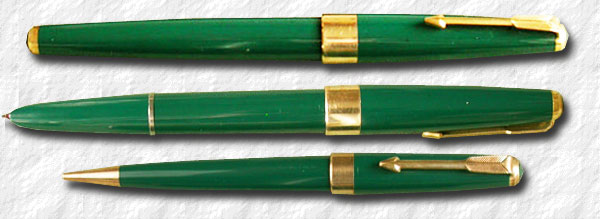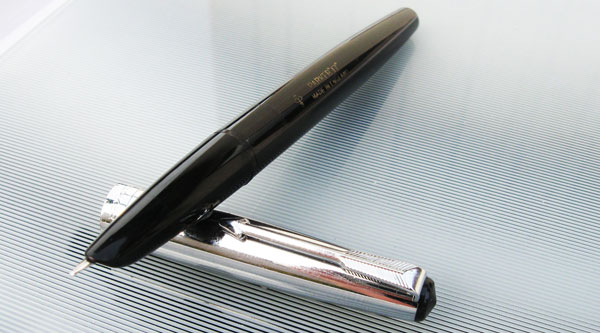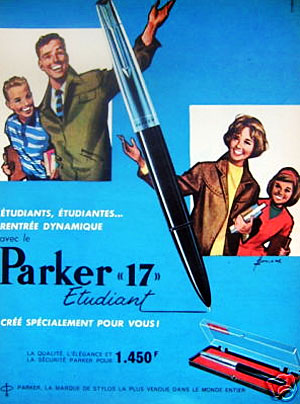
| parkerpens.net |
| PARKERCOLLECTOR.COM |
|
Parkercollector.com — Online for 24 years! Click to read:
|
1962-1972 |
|
The Parker "17" was introduced in 1962 in two designs, the Parker "17" Duofold and the Parker "17" Super Duofold (ca 137 mm, closed). The former with a thin cap ring and the latter with an unusually wide cap band and a tassie ring/jewel. Both had a slip-on cap, as opposed to the rest of the European Duofold line of the 1960's. They also sported a new style clip with more tapered feathers. The early models also had an open, beak-shaped 14k gold nib. The ends being wider and more pointed than later models, not unlike the Danish Parker Popular of the 1950's.They were offered in the four standard Duofold colours of the time, Black, Blue, Red and Green. These pens also sported metal cap grip-rings on the body. Twist-operated pencils were also offered. |
 |
|
A DeLuxe that was found with a Parker "51" MKIII style cap. The later DeLuxe "17" is identical to the Parker "51" MKIII, save the imprint. Image © courtesy of John Gilks
|
|
In 1967 a new model called the Lady Insignia was introduced that had a 12 k rolled gold barrel and cap in rolled gold, while the gripping section was in black plastic. It also sported a clip very similar to the clip of the Parker "45". |
 |
|
A blue and a red Parker "17" Lady from 1964. Image ©
|
|
Both the Lady Insignia and Lady Standard belonged to the Parker "17" family but were not imprinted as such. New old stock pens reveal that they had the name in white crayon on the body, but this seldom remains on used pens. |
 |
|
A green set Parker "17" Super Duofold, 1964. Image © Image © courtesy of Generation Pen
|
|
The Parker "17" was discontinued in 1972 but Parker continued to sell from it's large overstock for a few years. |
 |
|
A black Parker "17" DeLuxe. Image ©
|
 |
|
1960's ad. Image ©
|
|
© 1995-2020 Tony Fischier and The Parker Pen Company®/Sanford Ecriture. Everything on this website is copyrighted by law and can not be used without written permission from the author, Tony Fischier. You may however use the information as reference material and although it is forbidden to make digital copies or reproductions it may be physically printed for personal use, after a small donation, this does not include use on other web pages or in advertising. You may however quote parts of the content of this website, digitally or physically, providing that the source and author is clearly stated, together with the copyright information. In the US referred to as Fair use. If you use any information from this site for online purposes, you are required to add a link to this site. Feel free to donate through Paypal to help this site to stay online. This page is in no way sponsored by or created by the Parker Pen Company®. All opinions, views, and thoughts expressed herein are expressly the authors, and in no way reflect the opinions, views, or thoughts of the Parker Pen Company®/Sanford Ecriture. All logos and/or images on these pages are © Copyright of Parker Pen Company®Sanford Ecriture unless otherwise stated, and is reprinted by kind permission. If You feel that Your copyright has been violated please contact the WEBMASTER. |

